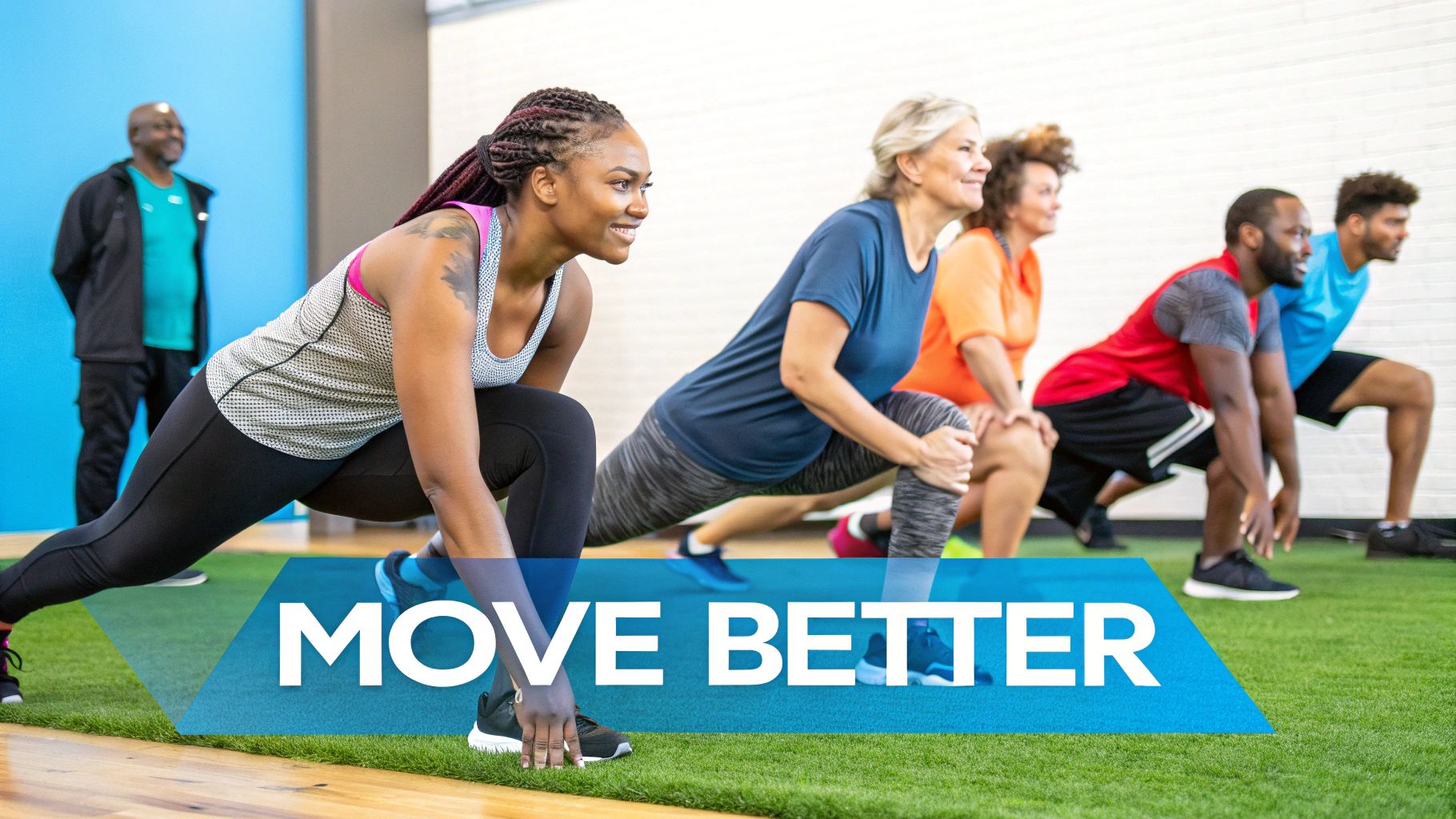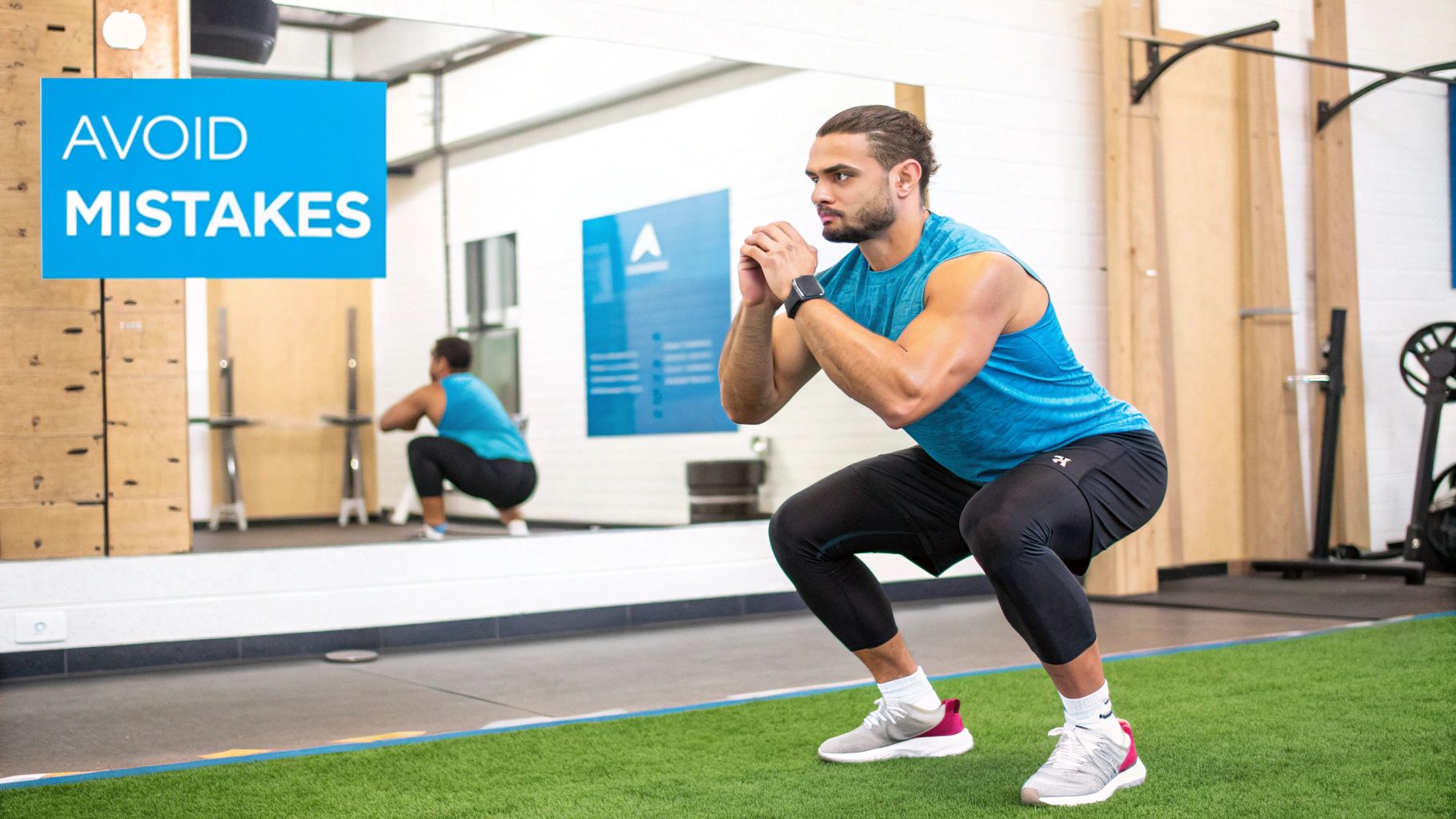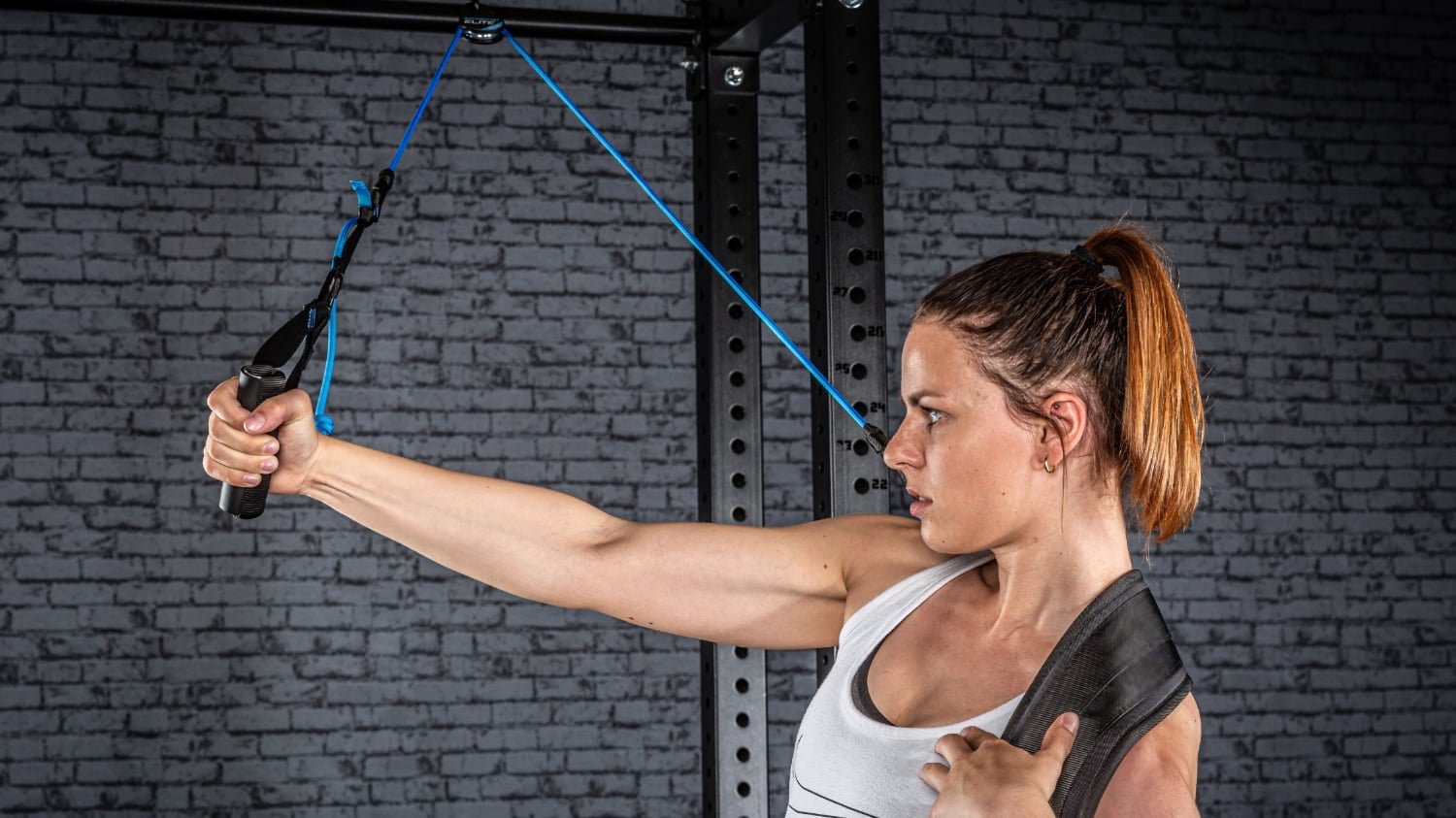Beyond The Gym: The Real Power of Functional Fitness

Traditional gym workouts often isolate specific muscles. This approach, however, doesn't always translate into real-world strength gains. That's where functional fitness workouts come in. Instead of isolation, functional fitness focuses on compound movements that work multiple muscle groups at the same time. These movements mimic everyday actions like lifting, pushing, and pulling.
Think about lifting a heavy box. A typical gym workout might include bicep curls and triceps extensions. A functional fitness workout would instead incorporate exercises like deadlifts or squats. These exercises engage the entire body, better preparing you for that real-world lifting task.
Functional fitness also improves mobility, balance, and coordination, elements often neglected in traditional training. This means you aren't just gaining strength; you're developing the skills to move efficiently and avoid injuries in your daily life.
The popularity of functional fitness is on the rise, particularly in Germany, where people are increasingly seeking workouts with tangible, everyday benefits. The German fitness market generated over €5.4 billion in annual revenue in 2023. This reflects a robust industry offering diverse training options, including functional fitness.
Even during the COVID-19 pandemic, Germany maintained a fitness club membership exceeding nine million annually. This consistent engagement with fitness further emphasizes the shift toward functional training, as people prioritize practical, applicable strength. Recognizing this demand, German gyms are increasingly incorporating functional zones. These zones are outfitted with kettlebells, resistance bands, and open areas for bodyweight training. To learn more about the German fitness industry, visit: https://www.statista.com/topics/6869/fitness-industry-in-germany/
Why Choose a Functional Fitness Workout?
Functional fitness workouts offer a variety of advantages:
- Improved Daily Life: Everyday activities, from carrying groceries to playing with kids, become noticeably easier.
- Injury Prevention: A stronger core, better balance, and increased mobility contribute significantly to reducing the risk of common injuries.
- Enhanced Athletic Performance: Functional training provides a solid base for various sports and activities.
- Full-Body Engagement: These workouts are highly efficient, working multiple muscle groups simultaneously.
- Increased Calorie Burn: Compound movements typically burn more calories than isolated exercises.
Moving Beyond The Traditional: Embracing Functional Movement
Functional fitness isn't solely about aesthetics; it's about building a body that's equipped for life. By focusing on movements that replicate everyday actions, functional fitness closes the gap between gym strength and real-world application. This approach not only builds muscle but also improves overall health and well-being, allowing individuals to live more actively and confidently.
The Seven Movement Patterns That Transform Bodies

The infographic above offers a quick comparison of three foundational functional fitness exercises: bodyweight squats, push-ups, and planks. It outlines recommended sets, reps, and duration for each. While each exercise focuses on different muscle groups, they all contribute to overall functional strength and fit well into a balanced workout routine. Finding this balance between different movement patterns is key for optimal results.
This section dives into the seven fundamental movement patterns at the heart of functional fitness: push, pull, squat, hinge, lunge, rotate, and carry. These aren't just gym exercises; they're basic human movements we've used for centuries. Mastering these translates to better performance in everyday activities.
Before we explore each movement in detail, let's take a look at a helpful table summarizing the key information. This table provides a clear overview of the seven essential functional movement patterns, their everyday applications, and examples of exercises for beginner, intermediate, and advanced levels.
| Movement Pattern | Everyday Application | Beginner Exercise | Intermediate Exercise | Advanced Exercise |
|---|---|---|---|---|
| Push | Pushing open a door, lifting objects overhead | Wall push-ups, Incline push-ups | Standard push-ups, Bench press | Decline push-ups, Handstand push-ups, Plyometric push-ups |
| Pull | Opening drawers, pulling yourself up | Inverted rows, Resistance band pull-aparts | Assisted pull-ups, Bent-over rows | Muscle-ups, Single-arm rows |
| Squat | Sitting down, standing up | Bodyweight squats, Box squats | Goblet squats, Front squats | Pistol squats, Barbell back squats |
| Hinge | Lifting objects from the ground | Glute bridges, RDLs with light weight | Conventional deadlifts, Kettlebell swings | Single-leg RDLs, Deficit deadlifts |
| Lunge | Walking, climbing stairs | Stationary lunges, Reverse lunges | Walking lunges, Curtsy lunges | Jumping lunges, Lateral lunges with weights |
| Rotate | Turning, throwing | Standing trunk rotations with light weight/medicine ball | Russian twists, Wood chops | Medicine ball throws, Cable rotations |
| Carry | Carrying groceries | Farmer's walks with light weights | Suitcase carries, Sandbag carries | Uneven carries, Overhead carries |
This table serves as a handy quick-reference guide for building your own functional fitness workouts. Remember to choose exercises that match your current fitness level and gradually progress to more challenging variations.
The Push Pattern: Building Upper Body Strength
The push pattern works your chest, shoulders, and triceps. It's essential for actions like pushing open a door or lifting something overhead.
The Pull Pattern: Developing Back and Bicep Strength
Pulling motions work your back, biceps, and forearms. Think of tasks like opening a drawer or pulling yourself up.
The Squat Pattern: Strengthening the Lower Body
Squats target your quads, glutes, and hamstrings. This pattern is fundamental for everyday actions like sitting and standing.
The Hinge Pattern: Protecting Your Back
The hinge pattern focuses on your glutes and hamstrings. It's crucial for lifting objects safely from the ground. Correct form is vital. How to master single leg deadlifts offers valuable insights into proper hinge technique.
The Lunge Pattern: Improving Balance and Stability
Lunges improve single-leg strength and balance, mirroring actions like walking and climbing stairs.
The Rotate Pattern: Enhancing Core Strength and Mobility
Rotation exercises strengthen your core and boost spine mobility, essential for everyday movements like turning or throwing.
The Carry Pattern: Building Total Body Endurance
Carrying exercises improve grip strength, core stability, and overall endurance, reflecting real-world tasks like carrying groceries.
By working these seven movement patterns into your workouts, you’ll build strength and mobility that directly benefits your daily life. These patterns develop a stronger physique and equip you with the movement skills you need to handle everyday challenges with confidence.
Building Your Functional Fitness Blueprint
Inspired to embrace functional fitness? Let's create a personalized plan to make it happen. Building a successful functional fitness routine requires a balanced approach, carefully managing intensity and recovery for consistent progress. It's about building a sustainable fitness lifestyle, not just sporadic workouts.
Structuring Your Training Week
Think of your fitness plan as a blueprint for your body. Start by deciding on your training frequency. Aim for two to three workouts per week, with enough rest between sessions for muscle recovery. Effective training isn't solely about how hard you work, but how effectively you recover. Just like studying, shorter, focused sessions with breaks are more effective than long, exhausting ones.
Programming Your Workouts
Each workout should incorporate exercises targeting the seven key movement patterns: push, pull, squat, hinge, lunge, rotate, and carry. This well-rounded approach ensures balanced muscle development and improved overall functionality. For example, a workout could include push-ups (push), rows (pull), squats (squat), and deadlifts (hinge).
When choosing exercises, consider your individual goals. If you're focused on athletic performance, you might prioritize explosive movements like plyometric push-ups and jump squats. If pain reduction is your goal, controlled movements and correct form are crucial.
Also, consider your current fitness level. Beginners should start with bodyweight exercises and gradually add weights or resistance bands. This progressive overload continually challenges your body while minimizing injury risk. Data from Germany highlights the importance of consistent exercise. More detailed statistics can be found here: https://www.statista.com/statistics/412934/frequency-of-recreational-exercising-playing-sports-germany/

Volume and Intensity: Finding the Right Balance
Volume refers to the total sets and repetitions you do for each exercise, while intensity refers to the difficulty level. Balancing these is vital for optimal results. Too much of either can lead to overtraining and injuries, while too little will limit your progress.
A good starting point is 3 sets of 8-12 repetitions for each exercise. You can adjust the intensity by changing the resistance, rest times, or exercise variations. For example, using a heavier kettlebell for swings increases intensity, as does shortening rest periods between sets.
Transitioning From Conventional Training
If you're switching from a traditional training program, don't discard all your previous exercises. Instead, gradually integrate functional movements into your routine. This allows your body to adapt to the new movement patterns and reduces muscle soreness. Focus on mastering the seven fundamental movements. Over time, you'll be able to handle more complex functional exercises and reap the full benefits of this training method. Remember, consistency and good form are key for long-term success.
The Essential Tools That Maximize Movement Quality
Forget pricey, single-purpose gym machines. Functional fitness focuses on versatile equipment that enhances natural movement. This section explores the most valuable tools for both home and gym workouts. We'll examine why equipment like kettlebells, resistance bands, and sling trainers often yield superior results compared to traditional machines, and how they can improve specific movement patterns. You'll learn how to create a minimal yet effective home gym and avoid the marketing hype surrounding countless fitness gadgets.
Kettlebells: The King of Functional Fitness
Kettlebells are more than just weights with handles. Their unique off-centered weight distribution allows for dynamic, fluid movements that engage multiple muscle groups at the same time. Think swings, snatches, and Turkish get-ups. These exercises build strength, power, and coordination—essential attributes for daily life.
Kettlebells are incredibly space-efficient and affordable, making them a great option for home workouts. They also enhance nearly all of the seven fundamental movement patterns (squat, hinge, lunge, push, pull, carry, and rotation), making them a versatile addition to any fitness program.
Resistance Bands: Versatile and Portable Powerhouses
Resistance bands provide variable resistance throughout an exercise, challenging your muscles in ways free weights can't. This helps build strength evenly and improve joint stability. Their portability is a major plus, enabling full-body workouts anywhere.
Resistance bands are also extremely budget-friendly. They effectively target push, pull, squat, and hinge movements, complementing kettlebell exercises perfectly.
Sling Trainers: Bodyweight Training Elevated
sling trainers, such as the aeroSling series from aerobis, utilize your own body weight as resistance. This makes them adaptable to all fitness levels. They’re ideal for building core strength, improving balance, and increasing body awareness.
While needing slightly more space than bands or kettlebells, they still offer a compact and versatile training solution. They are particularly effective for push, pull, and core-focused movements.
Choosing the Right Tools for Your Needs
The ideal equipment depends on your individual space, budget, and goals. If space is limited, resistance bands are an excellent place to start. For maximum versatility and a challenging workout, kettlebells are a fantastic choice. sling trainers are a great option for those looking to focus on core strength and bodyweight exercises.
To help you decide which equipment might be best for you, take a look at the comparison table below:
Functional Fitness Equipment Worth Your Investment
Compare the most effective functional training tools across practical considerations to build your ideal equipment collection
| Equipment Type | Cost Range | Space Required | Versatility Rating | Best For | Limitations |
|---|---|---|---|---|---|
| Kettlebells | $20 - $150+ | Low | High | Strength, Power, Conditioning | Requires proper technique to avoid injury |
| Resistance Bands | $10 - $50 | Very Low | Medium | Strength, Stability, Assistance Exercises | Resistance may be too low for advanced lifters |
| sling Trainers | $50 - $200+ | Medium | High | Core Strength, Bodyweight Training, Balance | Requires anchor point for setup |
This table provides a quick overview of how these three popular functional training tools stack up against each other. Consider your training style and available space when making your decision.
Ultimately, the key is to choose tools you enjoy and that fit into your lifestyle. Building a functional fitness routine shouldn't be complicated or expensive. With a few well-chosen pieces of equipment, you can transform your training and discover the true power of functional movement.
The Science of Functional Fitness Success

Functional fitness isn't just a popular workout; it's grounded in scientific principles designed to improve human movement. It's not about building bigger muscles; it's about developing neurological adaptations that enhance the connection between your brain and body. This brain-body link is often overlooked in traditional training programs.
Neurological Adaptations: The Brain-Body Connection
Functional exercises, emphasizing compound movements, demand complex coordination. This coordination challenges the nervous system, leading to improved motor control and proprioception – your body’s awareness of its position in space.
For example, balancing on one leg during a single-leg deadlift engages your balance and forces your nervous system to work more efficiently. This enhanced mind-body connection translates to better performance in everyday activities. It also reduces the risk of falls, particularly important as we age. Research indicates that after age 30, we begin losing muscle mass and strength, impacting our ability to perform daily tasks. Functional fitness directly addresses this age-related decline.
Muscle Engagement: Working Smarter, Not Harder
Functional exercises generally engage 5-7 times more muscle mass than isolation exercises like bicep curls. This increased muscle activation results in greater metabolic demands and a higher calorie burn, both during and after your workout. Think of it like this: a larger car engine burns more fuel, even when idling.
Similarly, functional training boosts your metabolism, helping you burn more calories even when you're not actively exercising. This increased calorie expenditure supports weight management and promotes overall health.
Real-World Benefits: From Office to Athletics
The advantages of functional fitness extend to diverse groups. Office workers can counteract the negative effects of prolonged sitting by integrating functional movements into their workday. This can be as simple as taking the stairs or performing short bursts of bodyweight exercises.
Seniors can maintain independence and lower their fall risk by participating in functional fitness programs tailored to improve balance and mobility. This becomes increasingly important as we age, with studies showing decreased balance and flexibility in older adults.
Athletes can also gain a performance edge through functional training. By improving core stability, power, and movement efficiency, athletes can enhance their sports performance and reduce their risk of injury. Functional exercises train movement patterns, not just isolated muscles, mimicking the demands of various athletic activities.
Ultimately, functional fitness empowers you with the strength and skills to excel in all aspects of your life, from daily tasks to peak athletic performance.
Avoiding the Pitfalls That Derail Progress
Even with the best intentions, many people make mistakes in their functional fitness routines. These errors can hinder progress and even increase the risk of injury. This section helps you identify and correct these critical training errors.
The Importance of Proper Form
One common mistake is prioritizing intensity over proper form. It's important to push yourself, but sacrificing technique can lead to injuries and ultimately hinder your gains. For instance, performing squats with a rounded back puts unnecessary stress on the spine. Instead, focus on maintaining the correct form throughout each repetition, even if it means reducing the weight or intensity.
Progression: A Gradual Process
Another common pitfall is trying to progress too quickly. Similar to how you wouldn't run a marathon before learning to walk, avoid attempting advanced functional exercises before mastering the basics. Gradually increase the difficulty of your workouts by adding weight, repetitions, or more challenging variations. This gradual progression helps your body adapt safely and effectively. To make sure you are progressing safely and effectively, incorporate regular fitness assessments, like those provided by resources like fitness testing protocols. Even small, consistent improvements accumulate over time, resulting in significant long-term gains.
Recognizing When Your Training Isn't Functional
Sometimes, what seems like functional training isn’t actually functional. If your exercises don't translate to improved performance in your daily life, re-evaluate your program. For example, if you're doing lots of bicep curls but struggle to lift a heavy box, your training isn't effectively targeting real-world movements. Choose exercises that mimic everyday actions, like squats, deadlifts, and presses.
Balancing Intensity and Technique
Finding the right balance between intensity and technique is key for optimal results. Pushing yourself too hard too soon can lead to burnout or injuries, while not challenging yourself enough will limit your progress. Listen to your body and adjust your workouts as needed. If you're constantly sore or fatigued, consider reducing the intensity or taking a rest day. If your workouts are becoming too easy, increase the challenge with heavier resistance, more challenging variations, or shorter rest periods between sets.
Addressing Program Design Flaws
Many functional fitness programs are ineffective because of poorly designed routines. Avoid exercises that isolate single muscles; this is better suited for traditional gym workouts. Instead, focus on compound movements that engage multiple muscle groups at the same time. This approach builds functional strength and improves efficiency, giving you a full-body workout in less time.
Prioritizing Recovery
Proper recovery is as important as the workout itself. Adequate sleep, nutrition, and rest days are essential for your body to adapt and rebuild after intense training. Neglecting recovery can lead to plateaus, overtraining, and a higher risk of injury. Aim for 7-9 hours of sleep each night, and make sure you're eating enough protein and nutrients to support muscle recovery. Don't forget to schedule rest days into your training routine to allow your body to fully recuperate.
Developing Body Awareness
Finally, develop body awareness. Pay close attention to how your body feels during each exercise. This awareness allows you to identify and correct any deviations in form, minimizing the risk of injury and maximizing the effectiveness of your workouts. Functional fitness is about moving with intention and control, not just going through the motions. By understanding your body and its movement patterns, you can customize your training to your individual needs and reach your full potential.
Living Functionally: Beyond Structured Workouts
Functional fitness isn't just about hitting the gym; it's a way of life. It's about moving with strength and intention in your everyday activities, not just during planned workouts. This section offers practical tips for weaving functional movement principles into your daily routine, turning everyday actions into opportunities to bolster your training.
Transforming Mundane Activities into Movement Opportunities
Even small tweaks to your daily routine can significantly boost your functional fitness. Skip the elevator and take the stairs. Carry your groceries in several trips instead of one to work your carry pattern. Park farther away from your destination to sneak in some extra steps. These seemingly minor changes add up over time, increasing calorie burn and improving your overall fitness.
Consider adding micro-workouts throughout your day. If you’re sitting for a long time, stand up and do a few squats, lunges, or push-ups. These quick bursts of activity counteract the downsides of prolonged sitting and keep your body active. Think of it like recharging your fitness battery throughout the day. While waiting for your coffee to brew, you can easily squeeze in a quick set of squats. This helps break up long periods of inactivity and keeps you moving. Check out our guide on balance training for more ideas on incorporating functional movements into your day.
Maintaining Movement Quality During Everyday Tasks
How you perform everyday tasks is just as crucial as dedicated workouts. Consider how you lift a heavy object. Do you use your legs and engage your core, or do you strain your back? Using proper lifting technique – hinging at the hips and keeping a neutral spine – reinforces the hinge pattern you practice during your functional fitness workouts.
This principle applies to various activities. Maintain good posture while sitting to engage your core and prevent slouching. When carrying objects, distribute the weight evenly to improve balance and stability. These mindful adjustments reinforce your functional training and help prevent compensations that can hinder your progress. For example, consistently carrying a heavy bag on one shoulder can cause muscle imbalances and poor posture. Switching sides regularly or using a backpack helps distribute the weight evenly, promoting better alignment.
Real-World Integration: Living a Functional Life
The real strength of functional fitness lies in its seamless integration into your daily life. Imagine effortlessly lifting your child, carrying heavy luggage up a flight of stairs, or maintaining your independence as you age. These are the tangible benefits of a functional lifestyle.
As we get older, our bodies naturally lose muscle mass, strength, and balance. However, functional fitness can help offset these age-related changes. Regular functional training helps preserve muscle mass, improves balance and coordination, and boosts overall mobility.
By incorporating functional movement principles into all aspects of your life, you cultivate sustainable movement health that will benefit you for years to come. Functional fitness becomes more than just an activity; it becomes a way of life.



Leave a comment
All comments are moderated before being published.
This site is protected by hCaptcha and the hCaptcha Privacy Policy and Terms of Service apply.